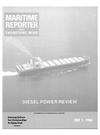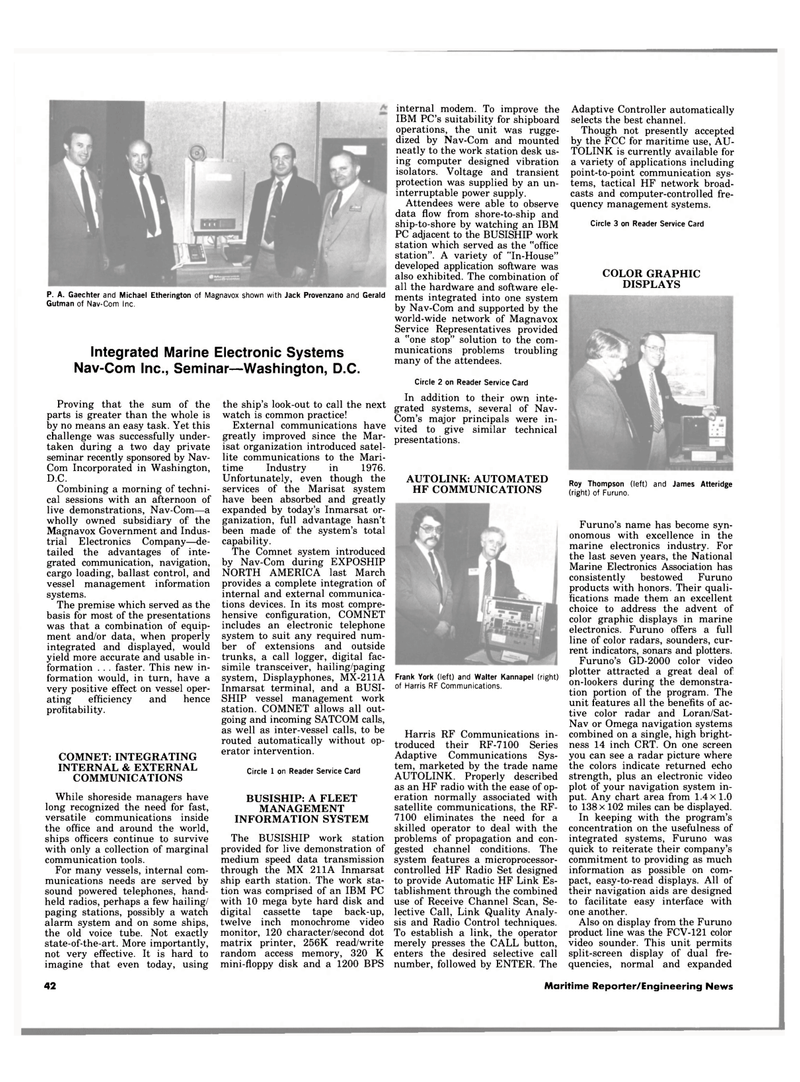
Page 40: of Maritime Reporter Magazine (July 1984)
Read this page in Pdf, Flash or Html5 edition of July 1984 Maritime Reporter Magazine
P. A. Gaechter and Michael Etherington of Magnavox shown with Jack Provenzano and Gerald
Gutman of Nav-Com Inc.
Integrated Marine Electronic Systems
Nav-Com Inc., Seminar—Washington, D.C.
Proving that the sum of the parts is greater than the whole is by no means an easy task. Yet this challenge was successfully under- taken during a two day private seminar recently sponsored by Nav-
Com Incorporated in Washington,
D.C.
Combining a morning of techni- cal sessions with an afternoon of live demonstrations, Nav-Com—a wholly owned subsidiary of the
Magnavox Government and Indus- trial Electronics Company—de- tailed the advantages of inte- grated communication, navigation, cargo loading, ballast control, and vessel management information systems.
The premise which served as the basis for most of the presentations was that a combination of equip- ment and/or data, when properly integrated and displayed, would yield more accurate and usable in- formation . . . faster. This new in- formation would, in turn, have a very positive effect on vessel oper- ating efficiency and hence profitability.
COMNET: INTEGRATING
INTERNAL & EXTERNAL
COMMUNICATIONS
While shoreside managers have long recognized the need for fast, versatile communications inside the office and around the world, ships officers continue to survive with only a collection of marginal communication tools.
For many vessels, internal com- munications needs are served by sound powered telephones, hand- held radios, perhaps a few hailing/ paging stations, possibly a watch alarm system and on some ships, the old voice tube. Not exactly state-of-the-art. More importantly, not very effective. It is hard to imagine that even today, using the ship's look-out to call the next watch is common practice!
External communications have greatly improved since the Mar- isat organization introduced satel- lite communications to the Mari- time Industry in 1976.
Unfortunately, even though the services of the Marisat system have been absorbed and greatly expanded by today's Inmarsat or- ganization, full advantage hasn't been made of the system's total capability.
The Comnet system introduced by Nav-Com during EXPOSHIP
NORTH AMERICA last March provides a complete integration of internal and external communica- tions devices. In its most compre- hensive configuration, COMNET includes an electronic telephone system to suit any required num- ber of extensions and outside trunks, a call logger, digital fac- simile transceiver, hailing/paging system, Displayphones, MX-211A
Inmarsat terminal, and a BUSI-
SHIP vessel management work station. COMNET allows all out- going and incoming SATCOM calls, as well as inter-vessel calls, to be routed automatically without op- erator intervention.
Circle 1 on Reader Service Card
BUSISHIP: A FLEET
MANAGEMENT
INFORMATION SYSTEM
The BUSISHIP work station provided for live demonstration of medium speed data transmission through the MX 211A Inmarsat ship earth station. The work sta- tion was comprised of an IBM PC with 10 mega byte hard disk and digital cassette tape back-up, twelve inch monochrome video monitor, 120 character/second dot matrix printer, 256K read/write random access memory, 320 K mini-floppy disk and a 1200 BPS internal modem. To improve the
IBM PC's suitability for shipboard operations, the unit was rugge- dized by Nav-Com and mounted neatly to the work station desk us- ing computer designed vibration isolators. Voltage and transient protection was supplied by an un- interruptable power supply.
Attendees were able to observe data flow from shore-to-ship and ship-to-shore by watching an IBM
PC adjacent to the BUSISHIP work station which served as the "office station". A variety of "In-House" developed application software was also exhibited. The combination of all the hardware and software ele- ments integrated into one system by Nav-Com and supported by the world-wide network of Magnavox
Service Representatives provided a "one stop" solution to the com- munications problems troubling many of the attendees.
Circle 2 on Reader Service Card
In addition to their own inte- grated systems, several of Nav-
Com's major principals were in- vited to give similar technical presentations.
AUTOLINK: AUTOMATED
HF COMMUNICATIONS
Frank York (left) and Walter Kannapel (right) of Harris RF Communications.
Harris RF Communications in- troduced their RF-7100 Series
Adaptive Communications Sys- tem, marketed by the trade name
AUTOLINK. Properly described as an HF radio with the ease of op- eration normally associated with satellite communications, the RF- 7100 eliminates the need for a skilled operator to deal with the problems of propagation and con- gested channel conditions. The system features a microprocessor- controlled HF Radio Set designed to provide Automatic HF Link Es- tablishment through the combined use of Receive Channel Scan, Se- lective Call, Link Quality Analy- sis and Radio Control techniques.
To establish a link, the operator merely presses the CALL button, enters the desired selective call number, followed by ENTER. The
Adaptive Controller automatically selects the best channel.
Though not presently accepted by the FCC for maritime use, AU-
TOLINK is currently available for a variety of applications including point-to-point communication sys- tems, tactical HF network broad- casts and computer-controlled fre- quency management systems.
Circle 3 on Reader Service Card
COLOR GRAPHIC
DISPLAYS
Roy Thompson (left) and James Atteridge (right) of Furuno.
Furuno's name has become syn- onomous with excellence in the marine electronics industry. For the last seven years, the National
Marine Electronics Association has consistently bestowed Furuno products with honors. Their quali- fications made them an excellent choice to address the advent of color graphic displays in marine electronics. Furuno offers a full line of color radars, sounders, cur- rent indicators, sonars and plotters.
Furuno's GD-2000 color video plotter attracted a great deal of on-lookers during the demonstra- tion portion of the program. The unit features all the benefits of ac- tive color radar and Loran/Sat-
Nav or Omega navigation systems combined on a single, high bright- ness 14 inch CRT. On one screen you can see a radar picture where the colors indicate returned echo strength, plus an electronic video plot of your navigation system in- put. Any chart area from 1.4x1.0 to 138 x 102 miles can be displayed.
In keeping with the program's concentration on the usefulness of integrated systems, Furuno was quick to reiterate their company's commitment to providing as much information as possible on com- pact, easy-to-read displays. All of their navigation aids are designed to facilitate easy interface with one another.
Also on display from the Furuno product line was the FCV-121 color video sounder. This unit permits split-screen display of dual fre- quencies, normal and expanded 42 Maritime Reporter/Engineering News

 39
39

 41
41
